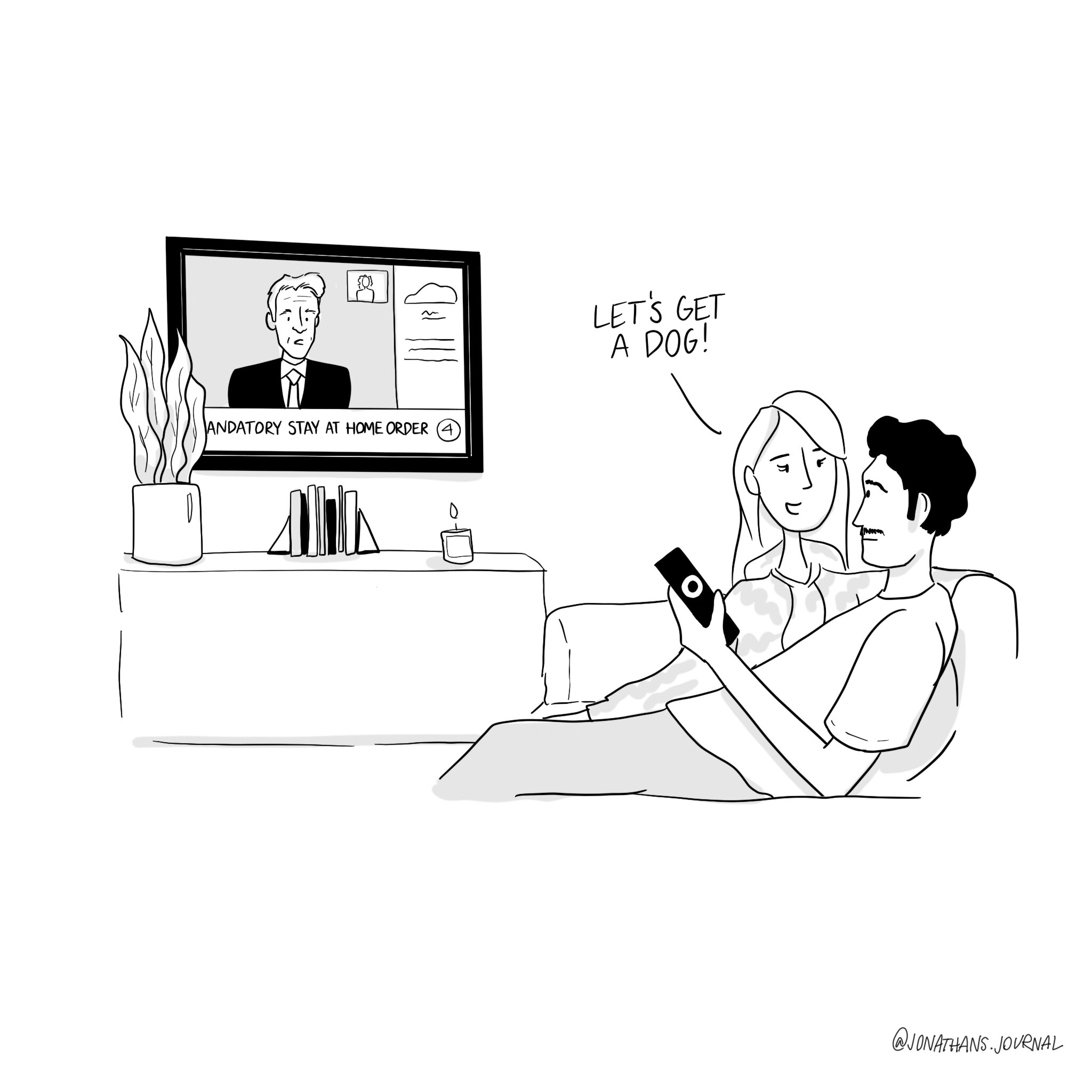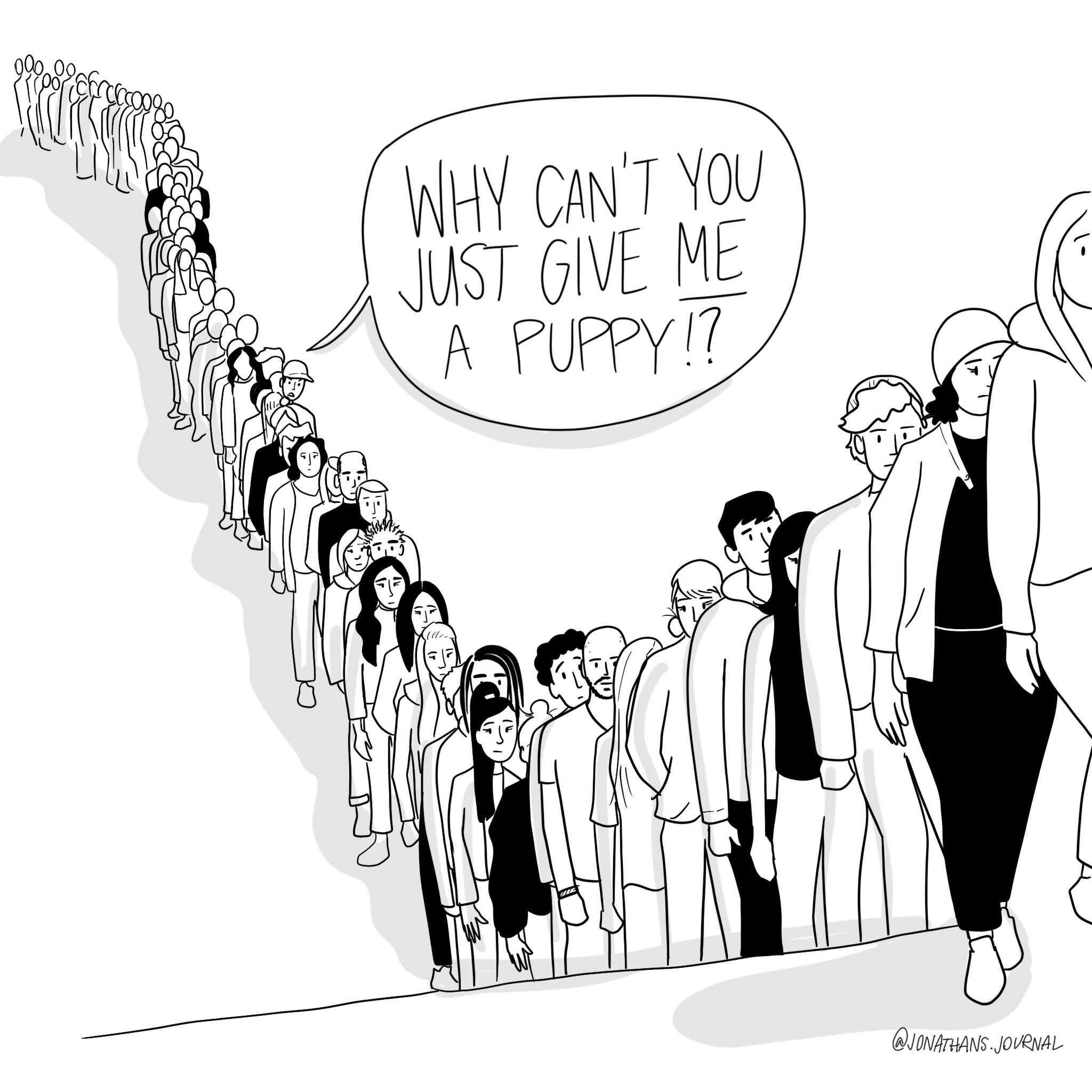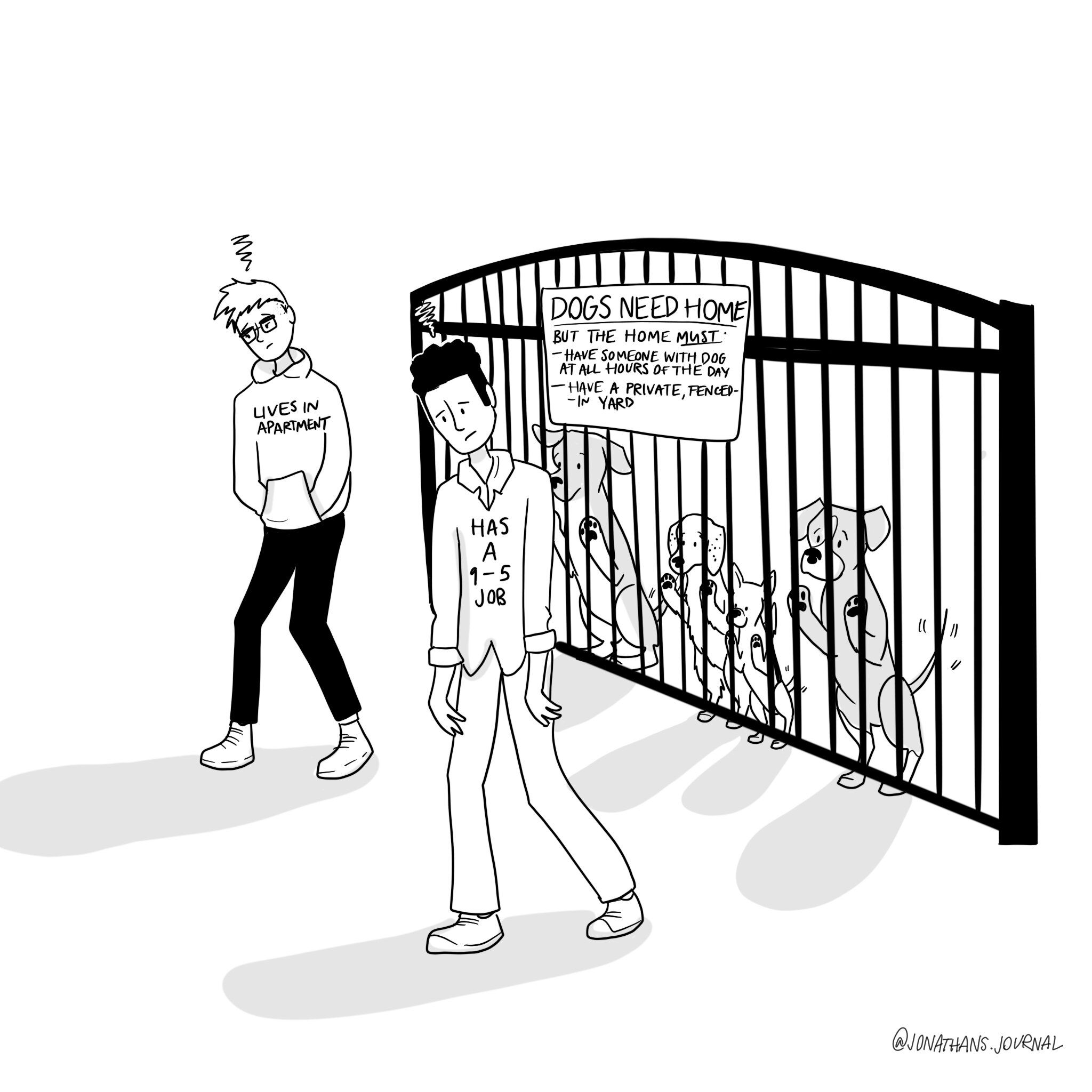Why is it so hard to adopt a dog?
The Covid-19 pandemic lockdown seemed like the perfect time to get a dog. Why not? You’ve been home; you finally have the time. Millions of people had the exact same idea, with “pandemic puppies” appearing suddenly all over your Instagram feed. On paper, it seems like a best case scenario for shelters and rescues. So many people are wanting to do the right thing and adopt a dog that needs a home. Shouldn’t it be easy to just fill out an application and get a dog that is already waiting?
Well, now it seems practically impossible. If you’re reading this, you have probably already sent in long applications that went nowhere with no response. The dog you applied for probably got snatched up before you even got your application viewed. Maybe your application was denied and you don’t know why. The dogs you want always seem to be adopted by someone else. Rinse… repeat… it feels like a cycle of going nowhere. Isn’t wanting to adopt a dog enough? Why aren’t you getting a response?
Why is the adoption process so laborious?
It often varies across organizations on how intensive the process is to adopt a dog. Many independent rescues have long, thorough applications that are followed by various interviews, background checks, reference calls, etc. On the other hand, a local shelter may let you show up, meet, and adopt a dog that day (pre-Covid, that is). Regardless of the organization, Covid has flipped the dog adoption blueprint upside down.
When researching where to apply for a dog, look at how the shelter or rescue’s adoption process operates. Many have an intensive process that you don’t know about. You may be wondering “Why can’t they just give me a dog?” Unfortunately, there’s a sad reality. There are crappy people out there, and these groups are doing everything they can to make sure their dogs are being adopted by loving homes that are willing to put in the work.
I adopted my dog through a foster-based rescue in New York City. Their dogs are transported from the South, mostly in the Alabama/Georgia/Northern Florida area. Our adoption process took about a month, and that was before Covid. I will go as far to say that I’m actually glad our process took that long.
The application itself was more than a few pages long and took a couple of hours to complete. We had to answer some thought-provoking questions such as “list the times your dog will be walked” and “in the case of a breakup, who of your domestic partnership will take the dog?” Questions like these took a lot of thought, planning, and difficult conversations with my partner. Questions this deep also deter less-than-serious applicants. If they aren’t willing to put in the work of this application, they certainly won’t be ready for the work that raising a dog entails.
Followed by our application, there were a handful of steps that we needed to pursue before we were officially able to adopt. We had to provide three references, a quick background check, and there was a virtual home visit. Of course, all of this was to assure we would be good dog owners, but it also helped the rescue know which of their dogs would work best for us. If we inquired about a dog that absolutely needed a yard, for example, they would know that the dog wouldn’t actually be a good fit for our living situation. Getting to know the applicants as well as they know the dogs ensures better placements, reducing the possibility of re-homing. Alternatively, if you apply for a specific dog that happens to get adopted by someone else, they can recommend another dog that is similar and fits your lifestyle.
The Covid influx
Everyone had the same idea to get a dog while they were working from home indefinitely. It is without a doubt amazing that so many people took to adoption first, but it is important to realize just how many people have hopped on this train. I spoke to a former Michigan shelter employee who said their shelter’s applications went from about 10-20 applications a day to 30-60 applications sent in a single day — that is tripled because of Covid. Plus, this was in a suburban/rural area. Imagine the tripled numbers in a city that has a high demand for dogs.
So many rescues or shelters rely on help from volunteers to do this work in their free time, which is usually after their full time jobs let out. For Waggytail Rescue in New York City, their volunteer staff only has about five people that take a look at adoption applications on a daily basis. This particular rescue, which regularly transports small breed dogs from high-risk situations once or twice a month, gets an average of ten applications per dog. Multiply that by how many dogs they bring into their fostering system every couple of weeks, and that is quite a pile of paperwork. Because they have so many smaller breeds, Waggytail is a favorite among the apartment dwellers of NYC. Although Waggytail may be as popular as ever, their staff has stayed the same. When those same five volunteers clock out of their full time jobs, they immediately go to working through the apps in the remaining hours they have in the day.
Unfortunately, the chances that someone gets to view your application within a day or two are extremely slim. It is entirely possible that your application will take over a week to be reviewed and moved forward to the next step of the process. This time frame has factors coming from all sides: the organizations adoption process guidelines, the number of volunteers, and the number of people applying all at once. You aren’t the only one that wants a dog, especially during Covid. Rest assured, they are getting to your application eventually, and don’t be worried if you don’t hear back in a few days.
Getting Denied
You may have run into a situation where your application was denied. It is undoubtedly discouraging, especially when you feel confident as a dog owner or got attached to a specific dog. Getting your adoption application denied is more common than you think, and the reasons behind it may be surprising.
Sometimes, you may get denied for a specific dog due to the fact he or she has an adoption pending. This happened to me and I quickly had to learn not to get completely attached to a dog, which is certainly easier said than done. Sometimes another applicant is a better fit for a dog you expressed interest in. Maybe the dog has specific needs that the other applicant has more experience with. The rescue might not be able to tell you these reasons, but this often doesn’t mean you are completely denied from the organization. All of these situations are okay and common, and it is okay to feel sad. However, I recommend not taking it personally, asking questions for feedback, and inquiring about other dogs. This can show the rescue that you are serious and willing to work to find the perfect fit for you and a dog.
In a conversation with a Waggytail Rescue volunteer, I was told that some applications may not be processed because of incompletion. “Given that we have few volunteers and many apps, we don’t reach out if the app is incomplete,” she wrote me over an Instagram message conversation. “So many people leave off their landlord contact or don’t list 3 references!” Accidents happen, but intentionally leaving these forms blank is a red flag or a waste of precious time for these volunteers. “Prior to Covid, we’d reach out to let them know [they left some forms blank,] but now we feel the onus is on the adopter to complete the app, not us to remind them.” Check and double check your application. If you don’t have landlord, make sure you write it down. If you don’t have references off the bat, take the two minutes to text a few friends and let them know you’re singing them up.
Although this isn’t the case with all rescues, Waggytails also recently put a hold on processing general applications that were not for a specific dog. These are categorized as applications that are generally just to adopt from the rescue that do not have any of their adoptable dogs listed. “We just don’t have the manpower to process them,” the volunteer explained while telling me about the Covid application pile-up. Unfortunately, there’s no real way to know if a rescue is favoring dog-specific applications versus general ones. It doesn’t hurt to ask, but Covid has made processes a little more unpredictable.
Gatekeeping is real
I would be remiss not to address the fact that not all rescue groups are created equal. While many are particular about who adopts their dogs within reason, there are also some flawed systems that are making adoption harder than it needs to be. It is a tough pill to swallow, but it may be affecting your chances to adopt a dog.
This is a subject that could be its own blog in itself, but among all the amazing rescues out there, there are still a few bad seeds that don’t have the most ethical or friendly of practices. Some have such particular adoption requirements that actually prevent a large population of people from adopting a dog. For example, not allowing any adoptions to people who live in apartments. While this can be an acceptable limit for a specific dog who would not succeed in an apartment, banning apartment dwellers as applicants is a form of gatekeeping, or “the activity of controlling, and usually limiting, general access”. This can inadvertently block people of certain socioeconomic status from providing a dog a loving home. Are you being prevented from adopting because of an unreasonable policy? It might mean to look at a different rescue.
I personally experienced an application denial by a rescue I ultimately realized was not an organization I wanted to support. On their application, they asked “what would be the breaking point for you to surrender a dog?” Because I already have one dog, I stated that if our second dog is violent with our first dog after months and months of training and exhaustion of resources, I would want the rescue to take the second dog and find a better suited home. I would not want either dogs to be under that much stress, and, like humans, some dogs just will not like each other. If either dog’s safety was at risk, I would want the rescue to take the dog again to find a home where he or she would be happier and anxiety-free.
Minutes after sending my application, the rescue swiftly denied me, stating that they immediately deny anyone who would surrender a dog for any reason. Frankly, I was shocked. As a firm believer that if a rehoming is needed, the original rescue, shelter, or breeder should take the dog back, I was certainly caught off guard by this policy. I understand that rehoming is sad and not ideal, but sometimes it is a necessity. Things happen, and sometimes homes simply are not a good fit for a dog. I considered my answer as an absolute worst case scenario, and if this rescue would want me to force a dog to continue to be unhappy (or my first dog to be in danger), I would not want to support them. While this policy of theirs did not come up until after the application was submitted, I am glad it was denied. I hope the dog I applied for finds a happy, loving, home.
What to do if you still are waiting for a dog
“We’re more inclined to check an [application] once the person has followed up a couple times,” I was told by the Waggytails volunteer. Do not be afraid to be a little pushy. It is okay to follow up on an email you sent a week ago to push it back to the top of their inbox. However, do not be rude if you haven’t gotten a reply in a few days. Being mean to the rescue will absolutely not help your chances. A kind follow-up shows you’re serious and the reviewers will commit your name to memory. Ask thoughtful questions about the rescue and available dogs. This shows you did your research and didn’t decide to adopt a pandemic puppy on a whim. If you get denied, ask why. Are they gatekeeping or was there something you need to reevaluate?
Don’t be afraid to apply to multiple places — but make sure each application is just as thorough as the last. Quality should not be sacrificed in this situation of quantity. Check out other dogs nearby apply for them (or wherever you’re willing to travel). If the dog is no longer available, continue with that application and inquire about other dogs. Also have other applications active in your queue so there are more options. If one falls through, there are still so many adoptable dogs out there: yours might just be somewhere else.
Whatever you do, don’t give up and drive to a random farm that will give you a puppy that day. Additionally, don’t find a website where you can just click and ship a puppy like it’s Amazon. No good, ethical, or reputable breeder is going to give you a puppy the first time you’ve met or spoken, let alone a few weeks later.. This is a sure sign of a puppy mill or backyard breeder, and this runs the risk of you getting a very unhealthy dog while financially supporting a person who is commercially breeding for profit.
Patience is important for dog ownership during and before you even get the dog. Instant gratification doesn’t exist when it comes to dogs, and if you can’t handle waiting for an adoption application to go through after a few weeks or months, you probably shouldn’t get a dog (news flash: potty training takes a very long time as well). Your perfect dog will come. While the adoption process is long, difficult, and full of waiting, you’re likely getting a dog regardless. The question of “when” may not be immediately answered, but there are good reasons why. Be patient, keep applying, and follow up. You’re going to have to put in the work before you even get the dog, but that’s a part of the deal. I promise that adoption is worth the wait.





